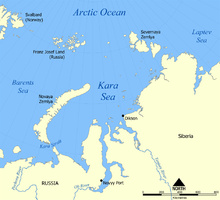Kara Sea
The Kara Sea (also Karisches Sea , Russian море Карское , Karskoje more ) is a north of Russia or Asia lying marginal sea of the Arctic Ocean .
geography
The Kara Sea extends from about 70 ° to 80 ° north latitude , or from 55 ° to 105 ° east longitude . It is bordered in the west by the arched archipelago of Novaya Zemlya , which contains the fourth and sixth largest islands in Europe. In the east, the Severnaya Zemlya archipelago and the Taimyr Peninsula form the framework. According to IHO, its northwestern border is the eastern end of the Franz Josef Land archipelago , at Cape Kohlsaat ( Graham Bell Island ). The isolated islands lie completely in the Kara Sea, from north to south Ushakov , Meadow Island and Solitude .
To the west lies the Barents Sea , which borders between Nowaya Zemlya and Franz-Josef-Land, and is connected in the south-west by Karastrasse and Jugorstrasse , which are to the north-west and south-east of the Waigatsch Island, respectively . In the east, Wilkizki Street , which extends between Severnaya Zemlya and the Taimyr Peninsula, leads over to the Laptev Sea to the east . To the north, between Franz Josef Land and Severnaya Zemlya, the open Arctic Ocean borders in the real sense.
In the south, the Kara Sea borders among other things on the Jamal Peninsula , which merges into the West Siberian lowlands to the south . It also borders the Gydan Peninsula , which merges with the North Siberian Lowlands to the east . Coming from the south, the massive water masses Ob and Yenisei flow into the Kara Sea in particular, which flow in with around 800 and 400 km long funnel mouths: the Obbusen between the Jamal Peninsula and the Gydan Peninsula; and the Yenisei Gulf east of the Gydan Peninsula. Both currents are jointly responsible for the flow conditions within this sea due to the very large amount of fresh water supplied to the Kara Sea and also determine its climate. The name is derived from the Kara River, which comes from the Urals and flows into the Baidarata Bay west of the Yamal Peninsula .
The Kara Sea is relatively shallow with an average depth of 127 m . At its deepest point, northeast of the north island of Novaya Zemlya , it is 620 meters deep.
mineral oil and natural gas
Media reports of a large oil and natural gas deposit under the Kara Sea, which is estimated at 87 billion barrels . According to Rosneft, the total oil reserves of the Kara Sea exceed those of Saudi Arabia.
ExxonMobil secured a 33 percent stake in 2012, with Russia being guaranteed access to American know-how that would enable it to develop oil in the extreme arctic conditions in the first place. Because of the Crimean crisis, the oil company had to withdraw from the business.
Footnotes
- ^ NTV (September 27, 2014): Rosneft reports success in oil exploration
- ↑ zeit.de January 20, 2017: The new oil man
- ↑ Donald Trump: Limitless Power . In: The time . January 20, 2017, ISSN 0044-2070 ( zeit.de [accessed January 20, 2017]).
literature
- The Kara Sea in the Encyclopedia Arctica (ca.1947 to 1951, unpublished)
Coordinates: 75 ° N , 71 ° E

